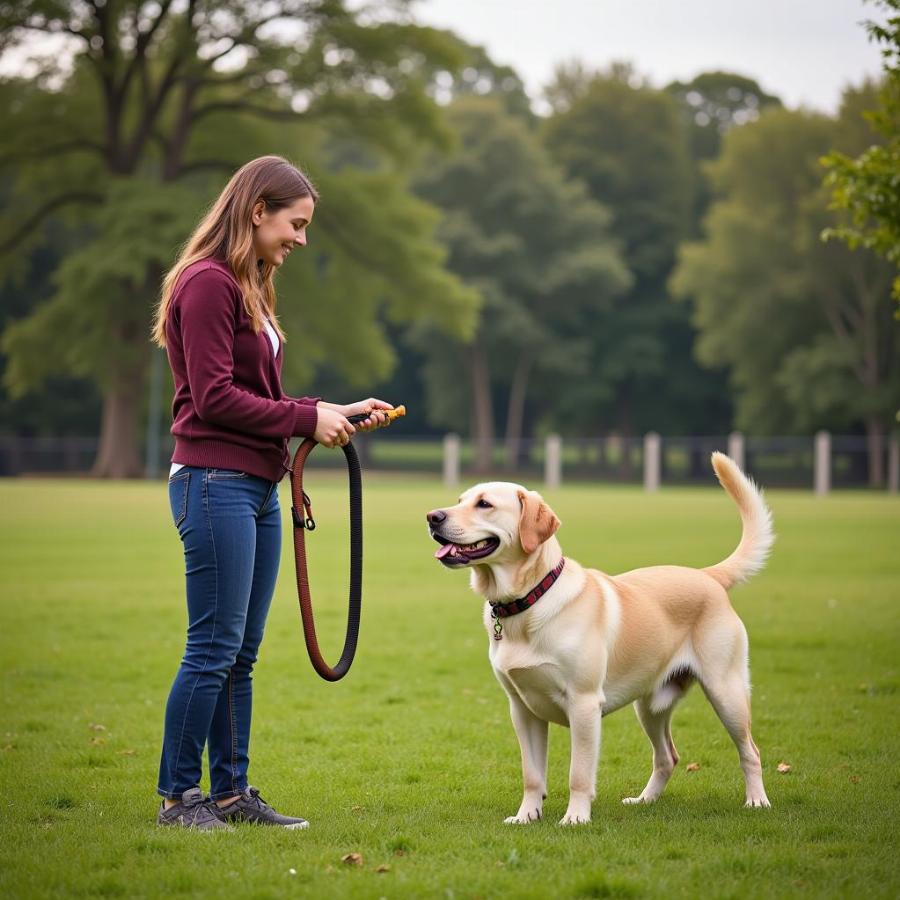A long line for dogs, also known as a training lead, is essentially a lightweight leash that extends far beyond your standard 6-foot leash. It offers a controlled freedom for your furry friend to explore while still providing you with a sense of security. Whether you’re working on recall training in the park or enjoying a leisurely hike in the woods, a long line can be a valuable tool for both you and your dog.
Why Choose a Long Line for Your Canine Companion?
A long line isn’t just about giving your dog more freedom; it’s a training tool that fosters a deeper bond and understanding between you and your dog. Here’s how:
- Enhanced Recall Training: A long line allows you to practice recall commands like “come” or “here” from a distance, gradually building your dog’s confidence and responsiveness.
- Safe Exploration: In open environments, a long line provides a safety net, preventing your dog from darting off after squirrels or approaching unfamiliar dogs and people.
- Improved Focus: With the extended distance, distractions become more prominent. Using a long line, you can work with your dog on maintaining focus on you even with tempting sights and smells around.
- Building Confidence: For dogs that are leash reactive or anxious in new environments, a long line provides a sense of security while allowing them to gradually acclimate to the surroundings.
Choosing the Right Long Line: Length, Material, and More
Selecting the appropriate long line is crucial for effective training and your dog’s safety. Consider the following factors:
- Length: Long lines typically range from 10 to 50 feet. For puppies and dogs new to long lines, start with a shorter length (around 10-15 feet) and gradually increase the distance as they master the basics.
- Material: Biothane, nylon, and rope are popular choices.
- Biothane is waterproof, easy to clean, and durable, making it suitable for various weather conditions.
- Nylon is a lightweight and affordable option, but it may not be as durable as biothane.
- Rope long lines are strong and provide a good grip, but they can be bulky and absorb water.
- Clip and Handle: Opt for a sturdy, rust-resistant clip that securely attaches to your dog’s harness. A comfortable handle ensures a secure grip and prevents rope burn during longer training sessions.
Mastering the Long Line: Tips for Successful Training
Using a long line effectively requires practice and patience. Here are some essential tips to get you started:
- Harness Up: Always use a well-fitted harness with a long line, never a collar. This prevents strain on your dog’s neck if they suddenly pull or reach the end of the line.
- Start Slow: Begin in a fenced area or a quiet, open space with minimal distractions. Allow your dog to get accustomed to the feeling of the line dragging behind them.
- Positive Reinforcement: Use positive reinforcement techniques such as treats, praise, and toys to motivate and reward your dog for staying close and responding to commands.
- Maintain Control: Never let the long line drag on the ground, as this can become a tripping hazard. Use a long line handle or learn to gather and hold the excess line in a safe manner.
- Practice Makes Perfect: Incorporate long line training into your regular walks and playtime. Gradually increase the distance and introduce distractions as your dog progresses.
 A woman using a long line to train her dog in a park setting.
A woman using a long line to train her dog in a park setting.
Long Line Safety: Essential Precautions
- Supervise Closely: Always supervise your dog when they’re on a long line. Be aware of your surroundings and potential hazards like obstacles, other animals, or people.
- Avoid Sudden Movements: Avoid jerking or pulling on the line abruptly, as this can startle your dog or cause injury. Use gentle guidance and verbal cues to redirect their attention.
- No Retractable Leashes: Never use a retractable leash as a substitute for a long line. The thin cord can cause burns and the locking mechanism can be dangerous if used improperly with a pulling dog.
- Choose Safe Environments: Opt for open, hazard-free areas for long line training and exercise. Avoid crowded places or areas with traffic.
Long Lines: Your Ticket to Freedom and Fun
Using a long line for dogs can be a rewarding experience for both you and your furry companion. It allows you to provide your dog with a sense of freedom while maintaining control and ensuring safety. Remember to choose the right equipment, practice patience, and prioritize positive reinforcement. With consistent training and a whole lot of love, you can unlock a new level of bonding and adventure with your dog!
FAQs About Long Lines for Dogs
Q: Can I use a long line with a puppy?
A: Yes, long lines can be beneficial for puppy training, but start with shorter lengths and gradually increase the distance as they grow.
Q: My dog is a strong puller. Is a long line safe?
A: Long lines can be used for strong pullers, but it’s crucial to start with basic leash manners training and use a well-fitted harness.
Q: Can I use a long line for tie-out?
A: No, long lines are not designed for tie-outs. They can be dangerous if left unattended and can cause injury.
Need more guidance on choosing the perfect long line for your dog? Looking for more training tips and tricks? Contact us at [email protected], and the experts at Beaut Dogs will be happy to assist you.
Beaut Dogs is your one-stop resource for all things dog-related, providing you with reliable and insightful information to enhance your life with your canine companion. Visit us today at https://beautdogs.com and discover a world of canine care and companionship!